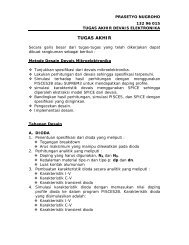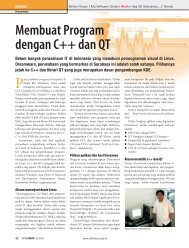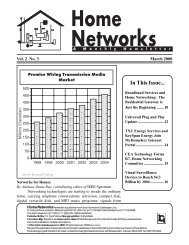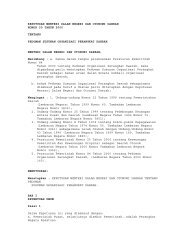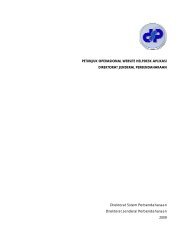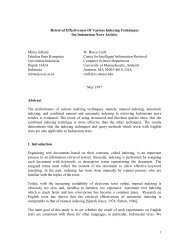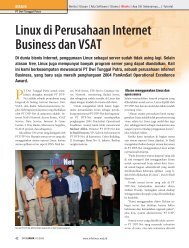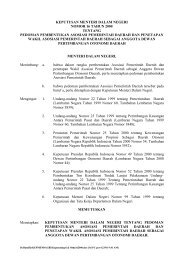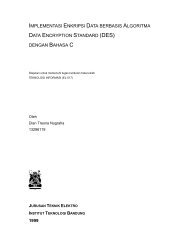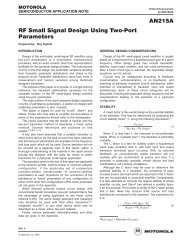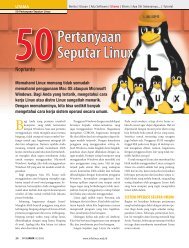Integrated Services Digital Network (ISDN) - Kambing UI
Integrated Services Digital Network (ISDN) - Kambing UI
Integrated Services Digital Network (ISDN) - Kambing UI
Create successful ePaper yourself
Turn your PDF publications into a flip-book with our unique Google optimized e-Paper software.
<strong>Integrated</strong> <strong>Services</strong> <strong>Digital</strong><strong>Network</strong> (<strong>ISDN</strong>)Luiz A. DaSilvaECpE 4614 - Telecommunication<strong>Network</strong>sVirginia TechLecture Objectives• Discuss the objectives of <strong>ISDN</strong>• Describe the <strong>ISDN</strong> architecture, channel structure andstandard interfaces• Provide a systems-level overview of ADSL• Reading Assignment : Stallings, Appendix A• Other sources : Roger Freeman, TelecommunicationsSystem Engineering, 3rd edition, 1996 (Chapter 13)• On the web: ADSL Forum (www.adsl.com)Luiz A. DaSilva, 1999 1
Evolution of <strong>ISDN</strong> (1)• Integration– Before WWII, integration of telegraph/telexand voice– More recently, integration of fax and voice– <strong>ISDN</strong> objective: integrate digital voice, 64-kbps data, telex, fax, slow-scan video– Broadband <strong>ISDN</strong> (B<strong>ISDN</strong>): all of the aboveplus video, multimedia, …Evolution of <strong>ISDN</strong> (2)• Channel– Analog public switched telecommunicationsnetwork based on the 4-kHz voice channel– Present digital network based on PCM: 64-kbps voice channel– In-channel signaling and framing corruptedthe 64-kbps channel, so integration of datarequired a drop-back to 56-kbps– <strong>ISDN</strong> : local interface to a “digital pipe”enables higher data ratesLuiz A. DaSilva, 1999 2
Principles of <strong>ISDN</strong> (1)• Support of voice and non-voice applications inthe same network– interfaces and data transmission facilitiesstandardized by ITU-T• Switched and non-switched connections– packet & circuit switching, leased lines• 64-kbps channel– chosen because at the time was the standardrate for digitized voicePrinciples of <strong>ISDN</strong> (2)• Layered protocol structure– mapped into OSI model (advantages inutilizing existing standards as well as indeveloping new ones)• Variety of configurations– according to specific national situations &state of technologyLuiz A. DaSilva, 1999 3
<strong>ISDN</strong> Conceptual ViewPBXPacket-switched NetCustomer<strong>ISDN</strong>InterfaceLocalLoop<strong>ISDN</strong>CentralOfficeOther <strong>Network</strong>sCircuit-switched NetLAN<strong>Digital</strong> PipesBenefits of <strong>ISDN</strong> (1)• To the user : cost savings and flexibility– integration of voice/data means users do nothave to buy multiple services to meetmultiple needs– single access line to all services– services tailored to diverse requirements(information volume, traffic pattern,response time, interface types)Luiz A. DaSilva, 1999 4
Benefits of <strong>ISDN</strong> (2)• To network providers– standards support universality and largerpotential market for services, drive downequipment costs• To manufacturers– larger potential market, economies of scales– standards decrease risk of obsolescence• To enhanced service providers– simplified user access<strong>ISDN</strong> Architecture (1)>64 kbpsnonswitchedTerminalEquipment(TE)<strong>Network</strong>Termination(NT)<strong>ISDN</strong>Switch>64 kbpsswitched64 kbpscircuit nonswitched<strong>ISDN</strong>Switchsubscribersite orserviceproviderUser-<strong>Network</strong>Signaling64 kbpscircuitswitchedpacketswitchedframemodecommonchannelsignaling<strong>Network</strong>Luiz A. DaSilva, 1999 5
<strong>ISDN</strong> Architecture (2)• Circuit-switched capabilities : 64-kbps• Non-switched capabilities : 64 kbps dedicated link,higher data rate provided by B<strong>ISDN</strong>• Switched capabilities : > 64 kbps switched connectionsusing ATM as part of B<strong>ISDN</strong>• Packet-switching capabilities : as provided by otherdata networks• Frame-mode capabilities : supporting frame relay• Common-channel signaling capabilities : used tocontrol the network and provide call management.Internal to the network, SS7 is used.<strong>ISDN</strong> Channels (1)• Standard bit rates:– B-channel : 64 kbps– D-channel : 16 or 64 kbps– H-channel : 384 (H0), 1536 (H11), 1920 (H12) kbps• B-channel is the basic user channel– can carry digital data, PCM-encoded digital voice,or a mixture of lower-rate traffic– with mixed traffic, all traffic must be destined forthe same end-point (carried over the same circuit)Luiz A. DaSilva, 1999 6
<strong>ISDN</strong> Channels (2)• B-channel (continued)– supports circuit-switched, packet-switched(exchange of data via X.25) and semipermanentconnections– in the case of circuit-switched connections, commonchannelsignaling is used• D-channel is dual-purpose– carries signaling information to control circuitswitchedcalls on B-channel– may be used to carry low-speed data applications(e.g., videotex, telemetry)<strong>ISDN</strong> Channels (3)• H-channel is a high-speed channel– can be used as a single trunk or subdivided by theuser– fast fax, video, high-speed data, high-quality audioand multiplexed information streams at lower datarates• These channel types are grouped into transmissionstructures that are offered as a package to the userLuiz A. DaSilva, 1999 7
Transmission Structures (1)• Basic access– Intended to meet the needs of individualusers (residences, small offices)– Composition: 2B+D (16 kbps D-channel) +synchronization and framing = 192 kbps– Most existing two-wire local loops cansupport this interfaceTransmission Structures (2)• Primary service– Users w/ greater capacity requirements(offices w/ a PBX or LAN)– In U.S.: 23B+D (64 kbps D-channel) = 1.544Mbps (T1)– In Europe: 30B+D (64 kbps D-channel) =2.048 Mbps (E1)– May also be used to support H-channels (e.g.3H0+D supplies a 1.544 Mbps interface)Luiz A. DaSilva, 1999 8
Interfaces (1)Interfaces (2)• In U.S., telephone company provides users with Uinterface– single-pair two-wire interface from phone switch– only a single device can be connected– NT-1 connects to U interface– in other parts of the world, phone company canprovide the NT-1 and users get S/T interface• <strong>Network</strong> Termination 1 (NT-1) converts 2-wire Uinterface into 4-wire S/T (system/terminal) interfaceLuiz A. DaSilva, 1999 9
Interfaces (3)• <strong>Network</strong> Termination 1 (NT1)– physical and electrical termination on user’spremises (OSI L1)– line maintenance, multiplexes several channels(synchronous TDM), supports multiple devices(multidrop)• Technically, need an NT2 device to convert T into S– layers 2/3 functions– usually NT2 integrated into other <strong>ISDN</strong> devicesInterfaces (4)• S/T interfaces support multiple devices– one pair for transmitting, the other for receiving– <strong>ISDN</strong>-capable phones and fax machines, videoconferencingequipment, bridges, routers andterminal adapters can connect to S/T interface --these are called Terminal Equipment 1 (TE1)• Terminal Equipment 2 (TE2) is not <strong>ISDN</strong>-capable buthas a POTS interface (common modems, phone, fax)– must connect through a Terminal Adapter (TA),sometimes called “<strong>ISDN</strong> modems”Luiz A. DaSilva, 1999 10
Interfaces (5)• TE2 connects to TA through R (rate) interface• Local loop connection is called Line Termination (LT)function• Connection to other switches within the phone networkis the Exchange Termination (ET) function• V interface between LT and ET<strong>ISDN</strong> Protocol ArchitectureApplicationPresentationSessionEnd-toendusersignalingTransport<strong>Network</strong>Data LinkPhysicalQ.931call ctl.X.25 otherLAPD (Q.921)FrameRelayI.430 basic interface + I.431 primary interfaceX.25LAPBControlSignalingPacket Telemetry CircuitSwitchedSemi-Perm.PacketSwitchedD channelB and H channelsLuiz A. DaSilva, 1999 11
Physical Layer• 2B1Q (2 binary, 1quaternary) mostcommon signalingmethod on U interface• 2 bits per symbol• 80 kbaud, 160 kbpsBits0001QuaternarySymbol-3-1VoltageLevel-2.5-0.83310+3+2.511+1+0.833Physical Layer Frame Format18 bits 216 bits 6 bitsSYNC 12* (B1 + B2 + D) Maintenance240 bits• Each frame 1.5 msec long• SYNC field (9 quaternaries) : +3 +3 -3 -3 -3 +3 -3 +3 -3• 12 * (8 bits from each B channel + 2 bits from D)• Maintenance contains CRC, other operation info.Luiz A. DaSilva, 1999 12
Link Access Protocol - D Channel(LAPD)• Layer 2 protocol• Almost identical to LAP-B used w/ X.25 (based onHDLC)• Provides unacknowledged information-transfer service(unnumbered frames, error detection to discard framebut no error control or flow control) and acknowledgedinformation transferPractical Issues (1)• Not available everywhere (typically, must be within18,000 ft of the telephone company equipment thatservices you)• Pricing (typical):– Installation charge (one-time)– Recurring monthly charge– Usage charge (typically a couple of cents perminute)Luiz A. DaSilva, 1999 13
Practical Issues (2)• When does it make sense to subscribe?– Internet access, remote office (individuals and smallbusinesses)– For continuous access, a leased line (e.g. T1) maymake more sense than switched <strong>ISDN</strong>– Cable modems and ADSL are alternativesAsymmetric <strong>Digital</strong> SubscriberLine (ADSL)Server1.5 to 9 MbpsCore<strong>Network</strong>ADSLADSLInternet16 to 640 kbpsSource: “ADSL Tutorial,” ADSL Forum, www.adsl.comLuiz A. DaSilva, 1999 14
Asymmetric <strong>Digital</strong> SubscriberLine (ADSL)• Physical layer transmission protocol (new modemtechnology)• Converts existing twisted-pair telephone lines intoaccess paths for multimedia and high speed datacommunications• Three information channels– high speed downstream channel– medium speed upstream channel– POTS or <strong>ISDN</strong> channelADSL Technology (I)Downstream Bearer Channelsn x 1.536 Mbpsn x 2.048 Mbps1.536 Mbps3.072 Mbps4.608 Mbps6.144 Mbps2.048 Mbps4.096 MbpsDuplex Bearer ChannelsC ChannelOptional Channels16 kbps64 kbps160 kbps384 kbps544 kbps576 kbpsLuiz A. DaSilva, 1999 15
ADSL Technology (II)• Data rates consistent with No. American and Europeandigital hierarchies• ADSL modems will accommodate ATM and IPprotocols• Downstream rates depend on length of copper wire,wire gauge, presence of bridge taps, etc.• ADSL modems incorporate forward error correctionADSL Technology (III)FDMUpstreamDownstreamPOTSFrequency1 M HzEcho CancellationUpstreamDownstreamPOTSFrequency1 M HzLuiz A. DaSilva, 1999 16
ADSL Technology (IV)• 4 KHz region at the DC end of the band is split off forPOTS• FDM assigns separate bands for upstream anddownstream data; downstream path is divided by TDMinto several channels• In echo cancellation, upstream and downstream bandsoverlap (same technique as V.34 modems)ADSL Advantages• Advantages - cost effectiveness to providers and addedvalue to users– Less costly than fiber alternatives– “Always on” connectivity more convenient, enablesremote office– Quality of connectivity is increased, enables newapplications such as videoconferencingLuiz A. DaSilva, 1999 17
ADSL Challenges• Seamless deployment (can expectations be met?)• Greater emphasis on user requirements (the technologyis not important to users, the applications it enablesare)• Speed and ubiquity of deployment will vary fromregion to region• Competition from cable modemsLecture Summary• <strong>ISDN</strong> supports a wide range of voice and non-voiceapplications in the same network. It provides a range ofservices using a limited set of connection types andmulti-purpose user-network interface arrangements.(From Recommendation I.120 - 1988)• ADSL transforms ordinary phone lines into high-speeddigital lines for fast Internet access, interactivemultimedia applications, telecommuting, video ondemand, etc. (From ADSL Forum)Luiz A. DaSilva, 1999 18



